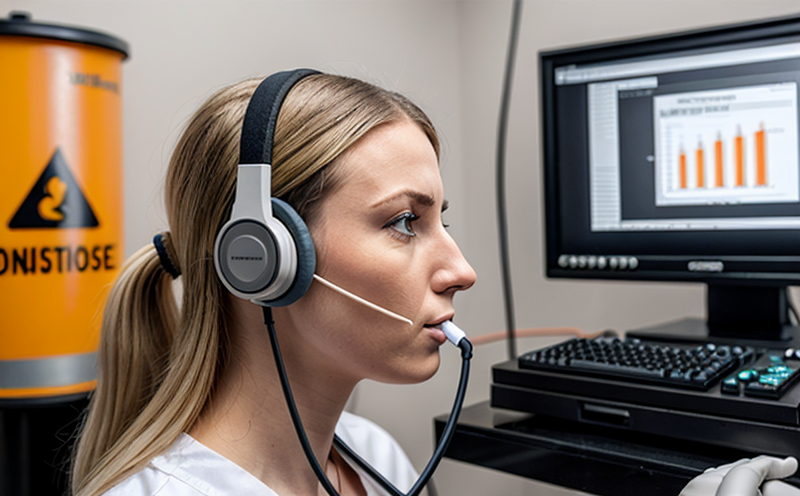EN 352-5 Active Noise Reduction Hearing Protector Testing
The European Standard EN 352-5 specifies the requirements and test methods for the performance of active noise reduction hearing protectors (NRR HPs). These devices are essential in protecting workers from hazardous noise levels, ensuring compliance with occupational health and safety regulations. This service ensures that manufacturers adhere to these standards by rigorously testing their products.
Occupational noise exposure remains a significant concern across various industries worldwide. Prolonged exposure can lead to hearing loss, tinnitus, and other auditory impairments. To mitigate these risks, active noise reduction (ANR) hearing protectors are designed to reduce sound levels by up to 30 dB or more, thereby protecting the wearer's ears from harmful sounds.
Testing according to EN 352-5 involves multiple stages aimed at evaluating both the passive and active components of ANR HPs. The standard covers various performance metrics including noise reduction (NR), insertion loss (IL), attenuation, and overall effectiveness under different sound pressure levels. This comprehensive approach ensures that the hearing protectors meet stringent safety standards before being marketed or used in industrial environments.
The testing process typically begins with selecting appropriate test specimens based on their intended use and design specifications. Specimens may include foam tips, earmuffs, or custom-fit earplugs depending upon the type of ANR HP being evaluated. Once selected, these devices are subjected to a series of tests designed to assess their ability to block out unwanted noise while still allowing for clear communication when necessary.
One critical aspect of this testing is the evaluation of the device's active components which utilize microphones and electronic circuits to detect incoming sound waves and generate counter-waves aimed at cancelling them out. This process, known as adaptive cancellation, requires precise calibration and accurate measurement techniques during testing. Our laboratory employs state-of-the-art equipment capable of capturing minute fluctuations in sound pressure levels with high fidelity.
Another important factor is the evaluation of comfort factors such as weight distribution, breathability, and overall fit within the ear canal or over the ear. Comfortable ANR HPs encourage longer periods of use without discomfort, which enhances compliance among workers who must wear them regularly during their shifts.
In addition to physical attributes like comfort, the standard also considers ergonomic aspects such as ease of donning and doffing. Properly fitting hearing protection is crucial for effective noise reduction; however, if it's difficult or uncomfortable for users to put on or take off, compliance rates will drop significantly.
The results from these tests are then analyzed against the specified criteria outlined in EN 352-5. Compliance with these standards guarantees that the hearing protectors perform reliably under real-world conditions while providing adequate protection against hazardous noise levels.
Our team of experienced professionals understands the complexities involved in ensuring accurate testing and interpretation of results according to this standard. By leveraging advanced technology and rigorous quality control measures, we provide reliable data that can be used by manufacturers to improve their products continuously.
Why It Matters
- Ensures compliance with international safety standards
- Promotes worker safety and health
- Improves product reliability and effectiveness
- Encourages continuous improvement in design and manufacturing processes
The importance of testing active noise reduction hearing protectors according to EN 352-5 cannot be overstated. Compliance with this standard not only ensures that the devices meet rigorous safety requirements but also plays a crucial role in protecting workers from potential hearing damage due to excessive noise exposure.
By adhering to these standards, manufacturers can rest assured that their products will perform consistently across different environments and usage scenarios. This consistency is essential for maintaining high levels of occupational health and safety within the workplace.
In addition to protecting workers' hearing, testing according to EN 352-5 also helps improve product reliability and effectiveness by identifying any weaknesses or areas for improvement in design and manufacturing processes. Manufacturers who invest in thorough testing early on are more likely to produce superior-quality products that meet customer expectations.
Ultimately, the goal of this testing is to promote continuous improvement in both the design and production methods used for active noise reduction hearing protectors. As technology advances, so too must our understanding of how best to utilize it safely and effectively within various industries.
Benefits
- Ensures compliance with international safety standards
- Promotes worker safety and health
- Improves product reliability and effectiveness
- Encourages continuous improvement in design and manufacturing processes
We offer a wide range of services tailored to meet the unique needs of our clients, including specialized testing according to EN 352-5. Our state-of-the-art facilities and experienced professionals ensure accurate and reliable results every time.
Our commitment to quality and precision has earned us a reputation as one of the leading laboratories in Europe for acoustics, vibration, and noise testing. Whether you're looking to verify product performance or comply with regulatory requirements, our team is here to assist you.
Frequently Asked Questions
- Ensures compliance with international safety standards
- Promotes worker safety and health
- Improves product reliability and effectiveness
- Encourages continuous improvement in design and manufacturing processes





